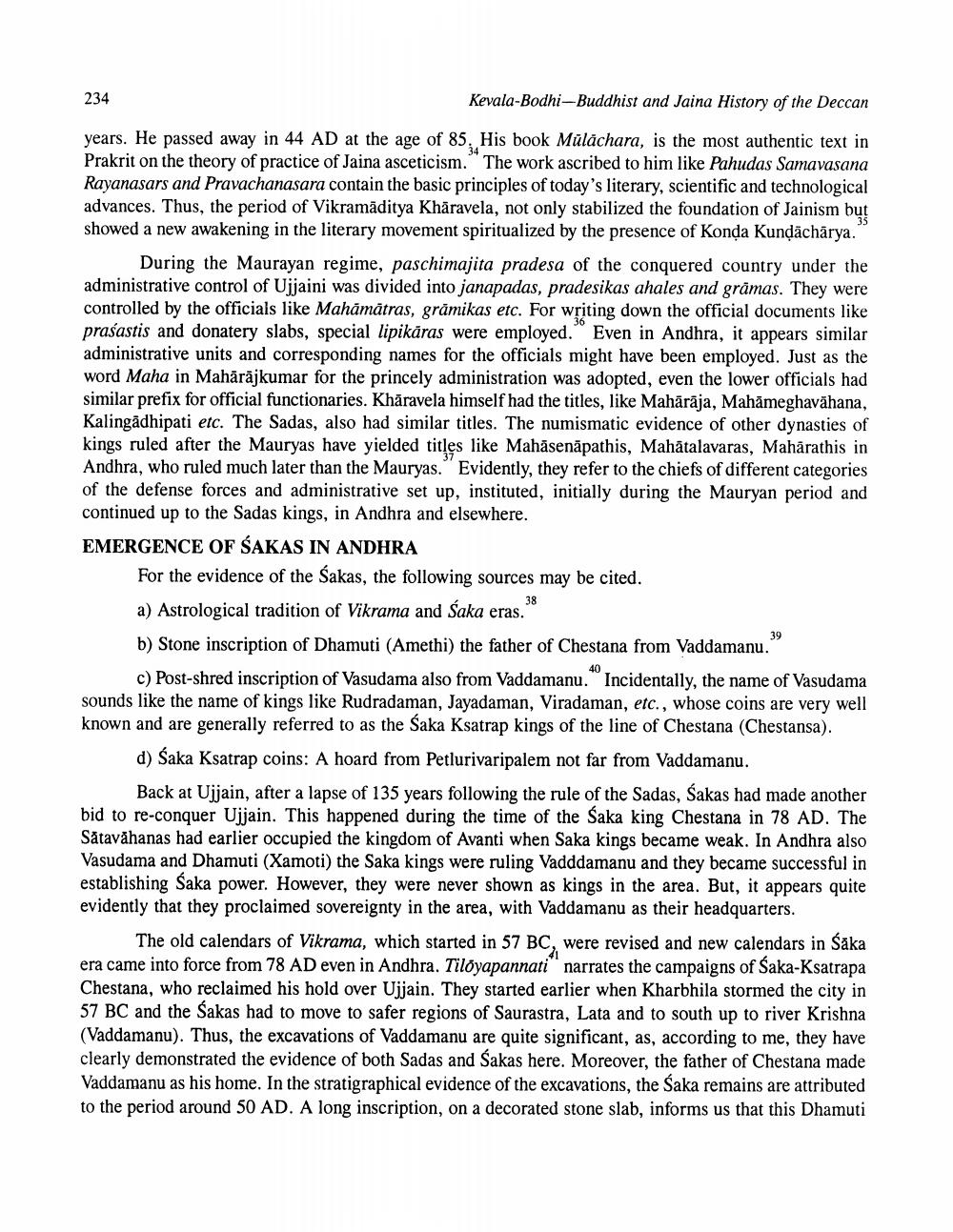________________
Kevala-Bodhi-Buddhist and Jaina History of the Deccan
years. He passed away in 44 AD at the age of 85, His book Mülachara, is the most authentic text in Prakrit on the theory of practice of Jaina asceticism. The work ascribed to him like Pahudas Samavasana Rayanasars and Pravachanasara contain the basic principles of today's literary, scientific and technological advances. Thus, the period of Vikramaditya Kharavela, not only stabilized the foundation of Jainism but showed a new awakening in the literary movement spiritualized by the presence of Konda Kunḍācharya.
35
234
During the Maurayan regime, paschimajita pradesa of the conquered country under the administrative control of Ujjaini was divided into janapadas, pradesikas ahales and gramas. They were controlled by the officials like Mahāmātras, grāmikas etc. For writing down the official documents like prasastis and donatery slabs, special lipikaras were employed. Even in Andhra, it appears similar administrative units and corresponding names for the officials might have been employed. Just as the word Maha in Maharajkumar for the princely administration was adopted, even the lower officials had similar prefix for official functionaries. Kharavela himself had the titles, like Mahārāja, Mahämeghavähana, Kalingadhipati etc. The Sadas, also had similar titles. The numismatic evidence of other dynasties of kings ruled after the Mauryas have yielded titles like Mahāsenäpathis, Mahâtalavaras, Maharathis in Andhra, who ruled much later than the Mauryas." Evidently, they refer to the chiefs of different categories of the defense forces and administrative set up, instituted, initially during the Mauryan period and continued up to the Sadas kings, in Andhra and elsewhere.
EMERGENCE OF SAKAS IN ANDHRA
For the evidence of the Sakas, the following sources may be cited.
38
a) Astrological tradition of Vikrama and Saka eras."
39
b) Stone inscription of Dhamuti (Amethi) the father of Chestana from Vaddamanu.
40
c) Post-shred inscription of Vasudama also from Vaddamanu." Incidentally, the name of Vasudama sounds like the name of kings like Rudradaman, Jayadaman, Viradaman, etc., whose coins are very well known and are generally referred to as the Saka Ksatrap kings of the line of Chestana (Chestansa).
d) Saka Ksatrap coins: A hoard from Petlurivaripalem not far from Vaddamanu.
Back at Ujjain, after a lapse of 135 years following the rule of the Sadas, Šakas had made another. bid to re-conquer Ujjain. This happened during the time of the Saka king Chestana in 78 AD. The Satavahanas had earlier occupied the kingdom of Avanti when Saka kings became weak. In Andhra also Vasudama and Dhamuti (Xamoti) the Saka kings were ruling Vadddamanu and they became successful in establishing Saka power. However, they were never shown as kings in the area. But, it appears quite evidently that they proclaimed sovereignty in the area, with Vaddamanu as their headquarters.
The old calendars of Vikrama, which started in 57 BC, were revised and new calendars in Śāka era came into force from 78 AD even in Andhra. Tilöyapannari" narrates the campaigns of Saka-Ksatrapa Chestana, who reclaimed his hold over Ujjain. They started earlier when Kharbhila stormed the city in 57 BC and the Śakas had to move to safer regions of Saurastra, Lata and to south up to river Krishna (Vaddamanu). Thus, the excavations of Vaddamanu are quite significant, as, according to me, they have clearly demonstrated the evidence of both Sadas and Sakas here. Moreover, the father of Chestana made Vaddamanu as his home. In the stratigraphical evidence of the excavations, the Śaka remains are attributed to the period around 50 AD. A long inscription, on a decorated stone slab, informs us that this Dhamuti




